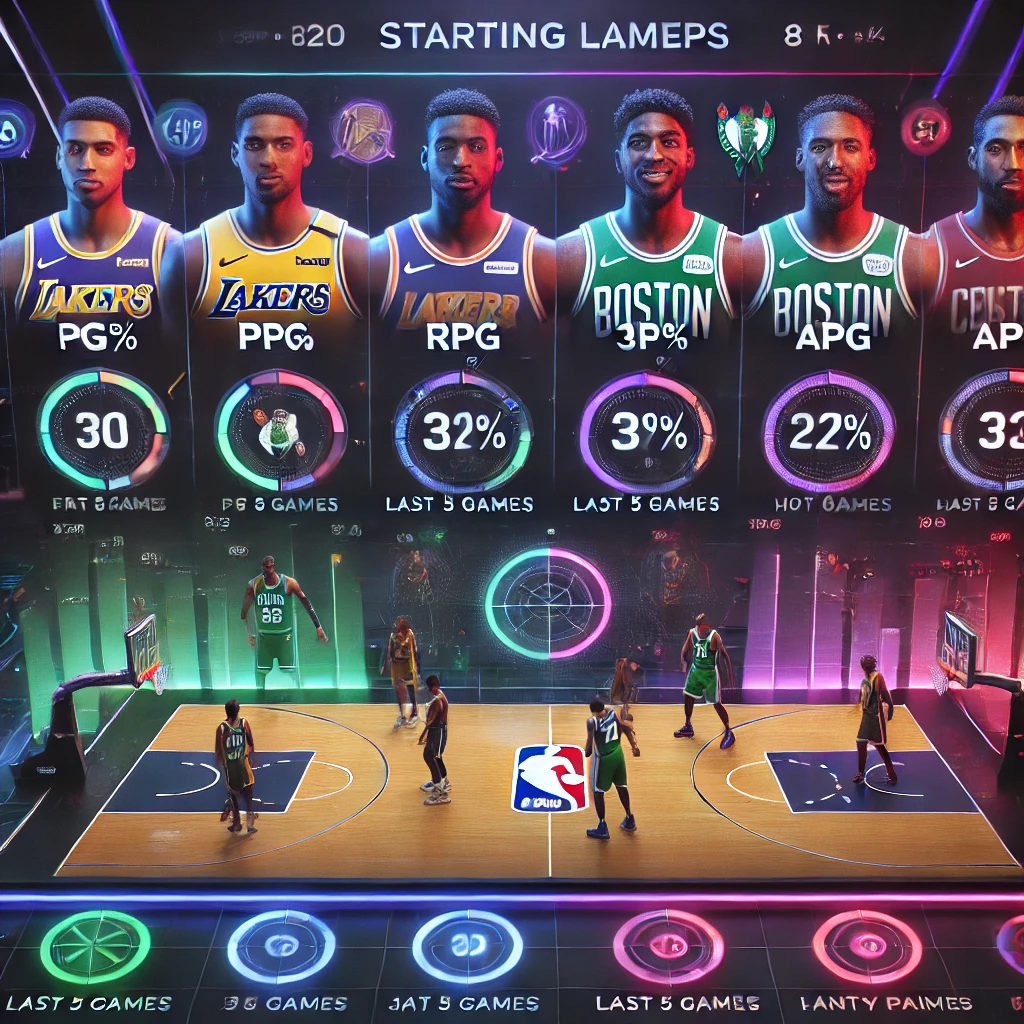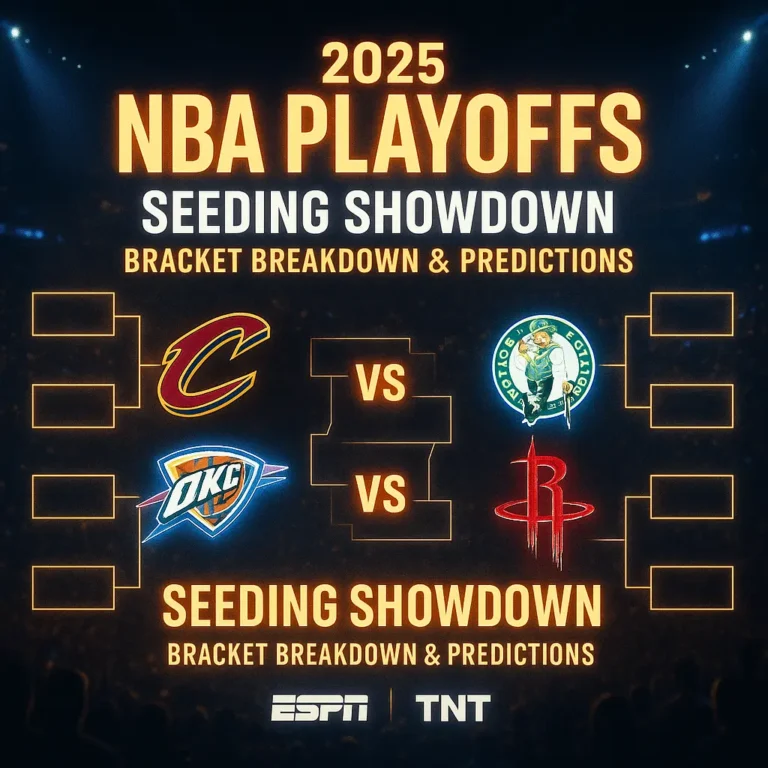NBA Starting Lineups
The NBA starting lineup is a critical aspect of each game, as it sets the stage for how teams will approach their matchups. A team’s starting five typically includes the players who will play the most minutes and take the first opportunity to make an impact on both ends of the floor. These lineups are chosen by coaches based on various factors, including player performance, matchups, injuries, and even rest schedules.
For teams, a consistent starting lineup helps establish chemistry and creates an identity on the court. For fans, it’s a key element of the game to follow, especially when it comes to analyzing how their favorite team is likely to perform.
NBA daily lineups not only influence a team’s strategy but also have a significant impact on fantasy basketball and betting. In fantasy leagues, knowing the starting lineup can mean the difference between a victory or defeat based on player performance. In the betting world, the starting lineup often plays a pivotal role in determining odds and predicting outcomes. Tracking these lineups and changes throughout the season can give fans, analysts, and fantasy managers the edge they need to succeed.
In this guide, we’ll explore how to track NBA starting lineups, the key resources for lineup updates, and how these lineups impact game performance, fantasy sports, and betting analysis.
🌍 How NBA Starting Lineups Are Determined
Setting the NBA starting lineup is a crucial decision that is primarily made by the head coach, who takes multiple factors into account. While the initial lineup may appear straightforward, it’s often influenced by a range of dynamic elements such as matchups, player performance, injuries, and the overall strategy for the game. Here’s an overview of how teams determine their starting five:
🏀 Coach Decisions and Strategy
One of the primary factors in determining a team’s starting lineup is the coach’s game plan. Coaches typically set lineups based on:
- Matchups: Coaches evaluate which players are best suited to counter the strengths and weaknesses of the opposing team. For example, a coach may start a player with strong defensive skills to guard the opposing team’s best scorer or a quicker player to exploit a slower defender.
- Team Chemistry: Coaches also consider the on-court chemistry of players. A lineup that works well together and has a strong understanding of each other’s playing styles can give a team an early advantage.
🏥 Injury Reports and Rest Days
Injuries and rest days are some of the most common reasons for changes in the NBA starting lineup. Coaches will often adjust their lineups to accommodate:
- Injured Players: If a key player is sidelined due to injury, the coach will typically substitute another player in the starting role or adjust the rotation accordingly. Teams may opt to start a more defensively or offensively inclined player, depending on the need.
- Rest and Load Management: In the modern NBA, rest days are often incorporated for star players, especially during back-to-back games. When a player is given a rest day, the coach may opt to start a bench player or give more minutes to a backup player. Load management has become common in the NBA, with coaches choosing to rest players on certain games to keep them fresh for the postseason.
💪 Player Performance and Rotations
While coach decisions and injuries are significant, player performance is one of the most vital factors in determining a starting lineup. Here’s how performance can influence a lineup:
- Recent Performance: Players who have been performing well in games or practice are more likely to start. Coaches assess a player’s shooting accuracy, defensive capabilities, and overall impact on the court. If a bench player has been excelling, they may earn a spot in the starting lineup.
- Matchup Adjustments: Lineups may shift during the season based on the evolution of a player’s performance or changes in the team’s overall dynamics. For instance, a player who was previously struggling may get a chance to start due to a strong performance in practice or a small sample of good games.
🔄 Rotations and Lineup Adjustments
The NBA season is long, and teams often adjust their lineups as the year progresses. Coaches use rotations to manage player fatigue and adapt to changing conditions:
- Bench Players and Role Adjustments: Sometimes, a coach will choose to start players who typically come off the bench if they have a favorable matchup or if they can provide a spark to the team. This could be a player with excellent shooting or defensive capabilities who could help balance the team’s scoring and defense.
- Lineup Shifts Throughout the Season: As the season goes on, coaches constantly evaluate performance metrics, matchups, and injuries, making subtle adjustments to the starting five. For example, a team may start the season with one lineup but shift to a more aggressive or defensive lineup as they approach the playoffs or when needed for specific matchups.
In conclusion, the NBA starting lineup is not set in stone but evolves based on a variety of factors. Coaches must constantly monitor player performance, injuries, and matchups to determine the optimal lineup for each game, ensuring that their team is competitive night in and night out.
📅 How to Track NBA Daily Lineups
🟩 Official NBA Resources
For NBA daily lineups, the most reliable and up-to-date source is NBA.com. The official NBA website provides detailed information about team rosters, injury reports, and starting lineups for every game, often updated shortly before tip-off. This is the go-to platform for the most accurate information directly from the league.
Other Reliable Sources include:
- ESPN: Known for its comprehensive coverage of NBA news, ESPN provides lineup updates, injury reports, and game previews.
- Rotoworld: A trusted resource for fantasy basketball, Rotoworld offers injury updates and lineup changes with quick updates for last-minute decisions.
- Twitter: Many NBA teams and beat writers share lineup updates and last-minute changes on Twitter. Following team accounts or reporters can help you stay informed on any sudden changes.
🟦 Using Apps and Fantasy Platforms
Several apps and platforms provide convenient ways to track NBA starting lineups on a daily basis:
- NBA App: The official NBA app allows fans to track live game updates, including starting lineups, injury reports, and real-time game stats. It’s a must-have for any NBA fan to stay updated on lineup changes.
- Yahoo Sports: Yahoo’s sports app not only provides lineup updates but also sends notifications about injury reports and game starts. It’s a valuable tool for both casual fans and fantasy basketball players.
Fantasy Platforms:
Fantasy basketball platforms like Yahoo Fantasy, ESPN Fantasy, and Sleeper offer detailed lineup data for fantasy owners. These platforms allow users to track lineup changes, player injuries, and player performance stats, helping them make informed decisions for their fantasy teams.
🏆 NBA Starting Lineups for April 10, 2025 – Key Matchups
Let’s look at the starting lineups for some exciting matchups on April 10, 2025, and how these lineups may impact the game:
🟩 New York Knicks vs. Detroit Pistons
Starting Lineups:
- NYK:
- Miles McBride (SG)
- Mikal Bridges (SF)
- Jalen Brunson (PG)
- Karl-Anthony Towns (C)
- P.J. Tucker (PF)
- DET:
- Delon Wright
- Cameron Payne
- Landry Shamet
- MarJon Beauchamp
- Kevin McCullar Jr.
- Analysis: The Knicks have a balanced starting lineup with key veterans like P.J. Tucker and the star power of Karl-Anthony Towns. Jalen Brunson will be key in orchestrating the offense, while Mikal Bridges provides versatility. The Pistons have a solid group, but their starting lineup will need to perform at its peak to compete with the Knicks’ defensive strength.
🟦 Cleveland Cavaliers vs. Indiana Pacers
Starting Lineups:
- CLE:
- Sam Merrill (SG)
- De’Andre Hunter (SF)
- Ty Jerome (PG)
- Dean Wade (PF)
- Jarrett Allen (C)
- IND:
- Tristan Thompson
- Chuma Okeke
- Javonte Green
- Isaac Okoro
- Luke Travers
- Analysis: The Cleveland Cavaliers have a solid starting lineup with Jarrett Allen at center, who is a major presence in the paint. De’Andre Hunter will provide defensive support, while Ty Jerome helps with playmaking. The Pacers, with players like Isaac Okoro and Javonte Green, will need to step up offensively to match Cleveland’s strength inside.
🟧 Atlanta Hawks vs. Brooklyn Nets
Starting Lineups:
- ATL:
- Dyson Daniels (SG)
- Zaccharie Risacher (SF)
- Trae Young (PG)
- Onyeka Okongwu (C)
- Clint Capela (PF)
- BKN:
- Caris LeVert
- Georges Niang
- Terance Mann
- Garrison Mathews
- Vít Krejčí
- Analysis: The Atlanta Hawks have a dynamic backcourt with Trae Young, supported by defensive stalwarts Onyeka Okongwu and Clint Capela. Brooklyn Nets will rely heavily on Caris LeVert for scoring, with an emphasis on defense from Terance Mann and Garrison Mathews. This game could be a high-scoring affair, with Trae Young leading the charge.
🟨 New Orleans Pelicans vs. Milwaukee Bucks
Starting Lineups:
- NOP:
- Antonio Reeves (SG)
- Keion Brooks Jr. (SF)
- Elfrid Payton (PG)
- Karlo Matković (C)
- Bruce Brown (PF)
- MIL:
- Jose Alvarado
- Jamal Cain
- Lester Quinones
- Yves Missi
- CJ McCollum
- Analysis: The Pelicans’ lineup brings a mix of veterans and young talents, including CJ McCollum who will be critical in scoring. The Milwaukee Bucks, while dealing with injuries, will look for contributions from their reserves like Jose Alvarado and Yves Missi.
🟩 Minnesota Timberwolves vs. Memphis Grizzlies
Starting Lineups:
- MIN:
- Anthony Edwards (SG)
- Jaden McDaniels (SF)
- Mike Conley (PG)
- Rudy Gobert (C)
- Julius Randle (PF)
- MEM:
- Joe Ingles
- Donte DiVincenzo
- Nickeil Alexander-Walker
- Naz Reid
- Terrence Shannon Jr.
- Analysis: Minnesota has an exciting lineup with the explosive Anthony Edwards and veteran presence from Mike Conley and Julius Randle. The Grizzlies, with their defensive duo of Joe Ingles and Nickeil Alexander-Walker, will need a big game from Naz Reid to stay competitive.
📊 Analyzing NBA Starting Lineups: Impact on Game Outcomes
🟩 The Role of Starting Lineups in Game Performance
The NBA starting lineup is crucial to a team’s overall game plan and strategy. The starting five players typically play the most minutes, and their roles are tailored to match the specific strengths and weaknesses of both their team and their opponents. Here’s how the starting lineup impacts the game:
- Influencing Matchups:
A coach carefully selects players for the starting lineup based on matchups. For example, if an opposing team has a strong center, the coach may start a player with better defensive capabilities in that position to minimize the opposing team’s scoring. Likewise, the lineup will be adjusted based on which player can exploit weaknesses in the opposing defense, such as a fast guard who can break down defenses or a sharpshooter who can create spacing. - Offensive and Defensive Balance:
A well-balanced lineup helps maintain both offensive firepower and defensive strength. Starting players like a true point guard to distribute the ball or a reliable shooting guard to score in clutch moments can make all the difference. Additionally, a strong defensive anchor in the lineup, such as a shot-blocking center, gives the team a solid foundation on defense, enabling them to execute their strategy more effectively. - Team Strategy:
The starting lineup often sets the tone for the entire game. Teams with a fast-paced offense may prioritize athletic players who can push the tempo, while teams that rely on methodical plays may start a lineup with higher basketball IQs, shooters, and ball handlers. The lineup selection directly impacts how the game flows, especially in the early stages when teams are establishing their rhythm. - Consistency and Team Success:
Teams that maintain consistency in their starting lineup often experience better results. Having the same players work together regularly builds team chemistry and improves overall performance. A consistent lineup leads to better communication, understanding, and execution, which translates into a higher chance of success over the course of a season. On the other hand, constant lineup changes can disrupt team cohesion and affect a team’s performance.
🟦 Fantasy Basketball and Betting Insights
The impact of NBA starting lineups extends far beyond the game itself, especially when it comes to fantasy basketball and betting. Understanding how to track lineups and using this information effectively can provide a major advantage in both areas.
Fantasy Basketball:
- Player Selection: Fantasy basketball leagues often assign points based on player performance, so knowing which players are in the starting lineup is crucial. Starters typically get more minutes and have higher chances of scoring points, grabbing rebounds, and making assists. By ensuring you have starters in your lineup, you increase your chances of maximizing your fantasy points.
- Impact of Injuries or Rest Days:
Injuries or rest days (especially during back-to-back games) can drastically affect a player’s fantasy output. If a key player is out or resting, their backup, often a bench player, might start and be a viable fantasy pickup for the day. Tracking last-minute lineup changes helps you spot these opportunities, allowing you to make quick adjustments to your fantasy roster. - Lineup Changes During the Game:
Players who come off the bench and outperform expectations can be valuable assets in fantasy basketball. Monitoring last-minute lineup announcements, especially right before the game starts, gives fantasy managers a competitive edge when choosing players for their lineup.
Betting Insights:
- Lineups Affect Betting Odds:
The official NBA starting lineup is critical when it comes to setting betting odds. For example, a star player being absent from the starting lineup (due to injury or rest) can shift the balance of a game. If the odds are adjusted based on this, it presents an opportunity for sharp bettors to place informed bets. - Injury Reports and Rest Days:
Last-minute lineup changes due to injuries or rest days can greatly influence betting lines. If a starting player is unexpectedly ruled out, it could affect a team’s ability to cover a spread or win outright. Bettors should stay informed about these changes to make more accurate predictions. - Team Performance Based on Lineups:
Teams with consistent starting lineups tend to perform better and have more predictable outcomes. For instance, a team that plays its top five regularly is likely to offer more stable betting opportunities. In contrast, teams frequently changing their starting five can be more unpredictable and harder to bet on.
💡 Key Takeaways:
- Understanding the role of the starting lineup is essential for game analysis, fantasy basketball, and betting.
- Lineup consistency contributes significantly to team success, while constant changes can disrupt performance.
- In fantasy basketball, knowing the starting lineup and tracking last-minute changes can help maximize points.
- For betting, being aware of lineup adjustments and player availability is crucial for making informed decisions.
🔄 NBA Lineup Changes Throughout the Season
🟩 Lineup Shifts Due to Injuries and Rest Days
Injuries and rest days are some of the most common factors that lead to changes in the NBA starting lineup throughout the season. Here’s how teams adjust their lineups to account for these factors:
- Injuries:
Injuries to key players can have a profound impact on the starting lineup. When a star player is sidelined, the head coach must adjust by either promoting a bench player to the starting lineup or altering the team’s rotation. For example, if a point guard gets injured, a team may promote a backup point guard or move another player, such as a shooting guard, into the starting point guard role.- Temporary Starters: Teams often rely on bench players who have proven themselves capable of contributing in larger roles. These players, while not expected to start at the beginning of the season, may get a chance to shine when a starter is injured.
- Injury Impact on Strategy: The absence of a key player, such as a center or shooting guard, forces the team to rethink their offensive and defensive schemes. Coaches may adapt the lineup to be more defensively minded or go in a different direction by emphasizing scoring from other players.
- Back-to-Back Games and Rest Days:
The modern NBA season is grueling, and players often have to play multiple games in a short span, especially during back-to-back games. To manage player fatigue, coaches may rest star players in certain games or reduce their playing time.- Load Management: Coaches have increasingly employed load management strategies, where key players (particularly veterans) are rested for one or more games during a back-to-back series or on particularly busy days. For example, LeBron James may sit out a game during the regular season to ensure he’s healthy for the playoffs.
- Lineup Adjustments: Resting a star player typically means starting one of the team’s role players or a bench player who has been performing well. These changes can create a temporary lineup shift, where different players step up to fill the void left by the resting star.
🟦 The Impact of Player Development and Trades
Throughout the NBA season, player development and trades can lead to significant changes in a team’s starting lineup. Here’s how both factors influence starting five decisions:
- Player Development:
As the season progresses, coaches are constantly evaluating player performance, especially for young players or rookies. Developmental players may earn a starting spot if they demonstrate growth in practice or during game situations. This is particularly true for rookies or second-year players who start the season coming off the bench.- Emerging Young Stars: If a rookie has a standout performance, they could be promoted to the starting lineup to provide a fresh energy or specific skill set (e.g., shooting, defense). For example, if a rookie guard has been excelling at shooting and creating plays, they may start in place of a veteran guard on rest days.
- Improved Bench Players: Bench players who improve their overall game throughout the season can also make a push for a spot in the starting lineup. Teams are always looking for players who can step up and fill gaps, especially if they can provide key contributions like scoring, defense, or rebounding.
- Trades and New Acquisitions:
Trades are another significant reason for changes in starting lineups. When a team acquires a new player, especially a star or key role player, that player may immediately be slotted into the starting five. This is particularly true when a contending team is looking to strengthen a position of need through the trade market.- Impact of Acquisitions: When teams acquire star players, such as a center to bolster rebounding or a shooter to improve perimeter scoring, the starting lineup must adapt to incorporate this new talent. The coach may adjust the lineup to maximize the effectiveness of the new player, whether that means pairing them with certain teammates or adjusting their role on offense/defense.
- Trades and Rotations: Teams that make a significant trade (e.g., acquiring a high-profile player like James Harden or Kevin Durant) will often change their rotations. A new player may immediately take a starting spot, and other players on the team may see their roles change in response.
In short, lineup changes throughout the NBA season are driven by factors such as injuries, rest days, player development, and trades. Coaches and teams must be flexible and adaptable, ensuring that their starting lineup is always optimized for the given circumstances of the game. Fantasy basketball managers and bettors alike should keep a close eye on these shifts, as they can significantly affect team dynamics and individual player performance.
🔍 Monitoring NBA Starting Lineups in Real Time
As the NBA season progresses, keeping track of starting lineups in real time is essential for fans, fantasy basketball managers, and bettors. Here’s a guide on where to find the most accurate, up-to-date lineup information and tools that can help you stay informed about changes:
🖥️ Where to Find the Most Accurate Updates
To ensure you’re getting the latest and most accurate information about NBA starting lineups, rely on these trusted platforms:
NBA.com
- NBA.com is the most authoritative source for lineup information, including official starting five announcements and last-minute changes. The website is updated regularly and provides reliable details about team rosters, injuries, and rotations. It’s the go-to place for checking starting lineups on game day.
ESPN
- ESPN’s basketball section offers daily updates on NBA starting lineups, including player statuses and any changes due to injuries or coach decisions. They also provide in-depth analysis, making it easy to understand how lineup shifts may affect a team’s chances.
Rotoworld
- Rotoworld is another valuable resource for lineup tracking, especially for fantasy basketball managers. The site offers detailed injury reports, player updates, and starting lineup confirmations, helping you make real-time adjustments for your fantasy team.
- Twitter is a great tool for following NBA beat writers and official team accounts. Many journalists and NBA teams post starting lineup changes, injury updates, and even game-time decisions in real time. This is particularly useful when you’re looking for last-minute changes before a game starts.
📱 Tools for Fans and Fantasy Managers
Keeping track of NBA starting lineups in real time is easier than ever, thanks to various apps and tools designed to streamline the process:
NBA App
- The NBA App is an excellent resource for live lineup updates, notifications, and game alerts. You can follow specific teams, check daily starting five announcements, and get injury reports all in one place. This app is indispensable for staying on top of lineup changes during the season.
Yahoo Sports
- Yahoo Sports provides live lineup tracking, especially for those involved in fantasy basketball. It gives quick updates on injuries, starting players, and rest days, allowing you to adjust your lineup quickly. The app also offers game alerts for all major changes.
Fantasy Platforms
- Fantasy platforms like Yahoo Fantasy, ESPN Fantasy, and Sleeper give users direct access to lineup data. These platforms notify users about starting lineups, injuries, and any other changes that could affect player performance. For fantasy managers, these platforms are invaluable when making daily adjustments.
⚙️ Tracking Lineups for Betting
For sports bettors, staying on top of NBA starting lineups is equally important. Lineup changes can shift the odds and influence betting decisions:
- Sportsbook Apps: Many sportsbook apps (such as DraftKings, FanDuel, or BetMGM) update their lines in real time as starting lineup announcements are made. Knowing who’s starting and who’s out due to injury can help you place smarter bets based on the updated team dynamics.
- Pre-Game and In-Game Analysis: Bettors should monitor NBA starting lineups before the game begins to assess matchups and overall team strength. Keep in mind that lineups for back-to-back games or key injuries can significantly alter betting lines. Betting strategies often rely on knowing whether a star player will sit out or if a backup player will start in their place.
📈 Tools for Real-Time Lineup Tracking
Here are some tools that can help you monitor NBA lineups throughout the day:
- Lineup Optimizer Tools: Some websites and apps provide lineup optimizers that help fantasy players and bettors track lineup changes and optimize their picks based on player availability.
- Live Injury Trackers: Websites like Injury Report or FantasyLabs offer real-time injury tracking which helps you stay updated on last-minute changes. These tools also offer projections and stats for players, making it easier to adjust your lineup accordingly.
Tracking NBA starting lineups in real time is essential for staying ahead in both fantasy basketball and sports betting. Whether you’re following the official NBA App, checking ESPN or Rotoworld, or relying on fantasy platforms, keeping track of the latest lineup updates will give you a competitive edge throughout the season.
🏁 Conclusion
Tracking NBA starting lineups is an essential practice for fans, fantasy basketball managers, and sports bettors. As we’ve seen, lineups can be influenced by various factors, including injuries, matchups, player development, and rest days. Understanding how these elements shape the game provides valuable insights that can enhance your viewing experience, help you make informed decisions in fantasy leagues, and even improve your betting strategies.
With real-time resources like NBA.com, mobile apps, and social media platforms, staying updated on daily lineups has never been easier. Whether you’re following the official NBA App or checking updates on Twitter, knowing who is starting each game can give you the edge in understanding team dynamics and player performance.
As the season progresses, lineups will continue to evolve. Coaches will make adjustments based on player performance, injuries, and strategic needs. By monitoring these changes, you can stay ahead of the game, ensuring that you never miss out on critical updates for your fantasy basketball roster or betting decisions.







